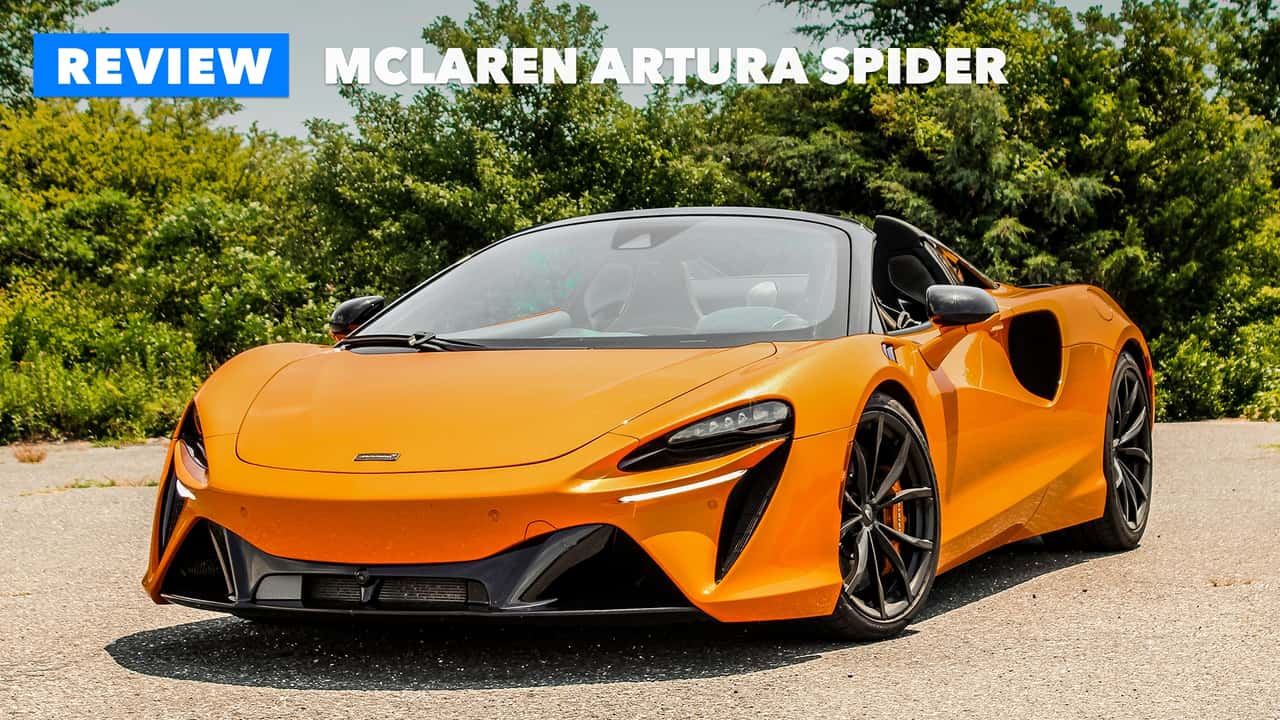

The McLaren Artura didn’t have the smoothest start. Fire concerns followed by months of delays during its 2023 launch painted a questionable picture of the British automaker’s newest mid-engine supercar. Finally, in 2025, the company has smoothed out production, with nary a hint of drama since.
Revisiting the Artura now is a revelation in just how far McLaren has come. Hybrid power brings it up to par with competitors, not just in terms of performance, but also in day-to-day usability. Striking looks draw stares from onlookers, while the cabin is among the best-designed in the entire segment.
The only thing the Artura lacks is a soundtrack to match.
| Quick Specs | 2025 McLaren Artura Spider |
| Engine | Twin-Turbo 3.0-Liter V-6 Hybrid |
| Transmission | Eight-Speed Dual-Clutch Automatic |
| Output | 690 Horsepower / 531 Pound-Feet |
| 0-60 MPH | 3.0 Seconds |
| Base Price / As Tested | $278,800 / $345,818 |
Mclaren Artura Pros
Amazing Looks
Driver-focused Cabin Space
Excellent Hybrid System
Pointy Front-End Handling
Every McLaren road car looks great, and the Artura Spider is no different. Carrying classic mid-engine proportions, it adopts the same sharknose-like front end as the rest of the company’s lineup, complemented by light pods shaped to evoke the style of McLaren’s crescent logo. The fascia is aggressive yet modern, something that’ll age gracefully for years to come.
The rear is a bit more subdued, borrowing its thin taillights from the McLaren GT. There’s no big wing or active aero to speak of, just a small lip spoiler and a diffuser. The niftiest bits in the rear are the see-through flying buttresses connecting the B-pillars to the rear decklid. Not only do they look cool, but they also improve visibility.
The Artura’s cabin is an exercise in driver focus. The optional bucket seats are phenomenal, allowing you to sit low in the carbon-fiber monocoque and feel more attached to the chassis. They’re also angle-adjustable, meaning you can dial in your driving position to suit your preferences. There’s even power lumbar adjustment, deterring backaches on long drives. The seats only cost $1,250, too, a relative bargain in the world of exotics.
The instrument cluster pod is attached to the steering column, so when you adjust the wheel, the digital gauge cluster moves along with it. At the top of each edge of the screen, there are rocker switches for moving between suspension and drive modes. That means you can adjust the car’s behavior without ever taking your hands off the wheel. It’s all delightfully intuitive.
The Artura’s hybrid system is equally easy to understand. The car always starts on battery power, so long as there’s enough charge in the 7.4-kilowatt-hour pack. In Electric mode, the wheels are spun through the axial flux electric motor mounted in the eight-speed dual-clutch. On a full charge, McLaren promises 21 miles of range before you ever need to fire the twin-turbocharged 3.0-liter V-6.
Switching to Comfort mode keeps the Artura on electric power, except for when you ask for more juice with the throttle pedal. The car will decide whether to turn the engine on or off, based on power demands and battery life. Looking to keep the engine firing at all times? Switch to Sport mode. Here, the engine runs by default, continuously trickle-charging the battery.

Photo by: Jonathan Harper / @jbh1126

Photo by: Jonathan Harper / @jbh1126

Photo by: Jonathan Harper / @jbh1126
Track mode is the most serious setting. The shifts are more violent, while the engine charges the battery more aggressively to keep power on tap for explosive acceleration. It sounds complex, but in practice, it’s very straightforward—especially compared to some competitors.
No matter the mode, the Artura Spider is a joy to drive. It’s comfortable enough around town to use as a normal car, with agreeable suspension and excellent outward visibility. The glass roof, which includes an electrochromic element to adjust light passing through, folds behind the cabin in just 11 seconds. Even if you never drive the Artura Spider 10/10ths, you’ll have a good time cruising.
Find a set of twisties, and the Artura transforms into a weapon. The added weight from the hybrid tech hasn’t ruined what made its predecessor, the 570S, so great. The lack of real aero or ultra-wide tires out back means the car feels light on its feet, ready to dance. You can legitimately squeeze some rotation out of this car while braking, even at semi-legal speeds.
The front end remains incredibly precise, thanks in part to McLaren’s continued use of hydraulic power steering. Combined with the thin, buttonless steering wheel, it’s a model of how a great sports car connects the driver to the road.
Straightaways are decimated in the blink of an eye, of course, thanks to the combined 690 horsepower on tap. The Artura feels at least as fast as a 720S, but without any of that car’s turbo lag.
The electric motor proves itself well worthy of the weight penalty every time you dig into the throttle.
McLaren Artura Cons
Lackluster Sound
You Can’t See the Engine
No Wireless CarPlay
The Artura Spider’s powertrain is objectively very impressive. It’s well-tuned for ease-of-use and explosive in its delivery. But the noise coming from the V-6 leaves a bit to be desired. It’s not bad, it’s just not very memorable. While V-6s are maligned for their sound characteristics, those from the likes of Ferrari and Lotus manage to create some truly exciting tones. McLaren, meanwhile, has dropped the ball.
In typical McLaren fashion, the Artura Spider also completely hides the powertrain under inaccessible panels, meaning only those with “Certified McLaren Technician” plastered across their mechanic jumpsuit will be able to see it. It’s a small complaint, but the people who buy these sorts of cars want to admire the engineering and design that goes into them. So why not show it off?

Photo by: Jonathan Harper / @jbh1126

Not a very exciting view.
Photo by: Jonathan Harper / @jbh1126
Another small complaint: The Artura still doesn’t have wireless Apple CarPlay or Android Auto. You’ll need a USB-C cable to fully connect your phone to the vertically oriented touchscreen. Fairly surprising, considering McLaren’s otherwise forward-thinking direction.
At least the Artura Spider is cheap (for what it is, anyway). Starting at $278,800 including destination, it undercuts its closest competitor, the Ferrari 296 GTS, by over $100,000 (though the McLaren does have 129 fewer horsepower). It’s about as expensive as a Maserati MC20 Cielo, a car that has no hybrid assistance at all. Only the Corvette ZR1X represents a better value, but that car is far heavier, and no one’s driven it as of this writing.
Our particular tester was equipped with just about every option available. In addition to the bucket seats and that fancy electrochromic roof, it also wore 10-spoke forged alloy wheels ($4,950), a carbon fiber interior pack ($4,050), a sports exhaust ($5,100), and a stunning shade of Papaya Spark orange paint ($9,500), among other add-ons. All in, MSRP was $345,818.
If it were me, I’d opt for the seats, the exhaust, and the fancy paint color, then save that extra cash for brakes, tires, and track day entry fees. Sound aside, this thing’s a blast.
Competitors
Ferrari 296 GTS
Maserati MCPura Cielo
Chevrolet Corvette ZR1X
Porsche 911 Turbo S Cabriolet
Aston Martin Vantage Roadster
Mercedes-AMG SL63 S E-Performance
What Makes a McLaren, A McLaren?
The McLaren Artura Spider Makes the Coupe Irrelevant


























































